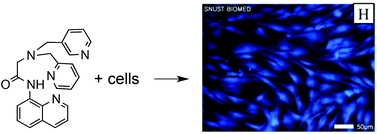Zinc sensors with lower binding affinities for cellular imaging†
Abstract
Zinc sensors based on 2,3-dipicolylamine (DPA) and

* Corresponding authors
a
Department of Fine Chemistry, Seoul National University of Science and Technology, Seoul 139-743, Korea
E-mail:
chealkim@seoultech.ac.kr
b
Department of Chemistry and Biochemistry, Brigham Young University, Provo, Utah, USA
E-mail:
roger_harrison@byu.edu
c Department of Chemical Engineering, Seoul National University of Science and Technology, Seoul 139-743, Korea
d Department of Chemistry and Nano Science, Ewha Womans University, Seoul 120-750, Korea
Zinc sensors based on 2,3-dipicolylamine (DPA) and

 Please wait while we load your content...
Something went wrong. Try again?
Please wait while we load your content...
Something went wrong. Try again?
J. H. Kim, I. H. Hwang, S. P. Jang, J. Kang, S. Kim, I. Noh, Y. Kim, C. Kim and R. G. Harrison, Dalton Trans., 2013, 42, 5500 DOI: 10.1039/C3DT33024A
To request permission to reproduce material from this article, please go to the Copyright Clearance Center request page.
If you are an author contributing to an RSC publication, you do not need to request permission provided correct acknowledgement is given.
If you are the author of this article, you do not need to request permission to reproduce figures and diagrams provided correct acknowledgement is given. If you want to reproduce the whole article in a third-party publication (excluding your thesis/dissertation for which permission is not required) please go to the Copyright Clearance Center request page.
Read more about how to correctly acknowledge RSC content.
 Fetching data from CrossRef.
Fetching data from CrossRef.
This may take some time to load.
Loading related content
